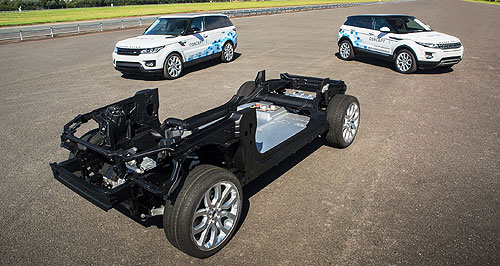Make / Model Search
News - General News - TechnologyJLR showcases future electric drivetrain techBritish sandwich: Jaguar Land Rover says its prototype next-generation electric drive modules could be fitted between any combustion engine and transmission to create a mild or plug-in hybrid system. Next-gen electric drive systems could make any drivetrain hybrid: Jaguar Land RoverGallery Click to see larger images 10 Sep 2015 JAGUAR Land Rover is working on next-generation electric drivetrain technology encompassing a modular electric drive module, designed to be inserted between any engine and transmission to create a hybrid and claimed to be capable of producing double the power and torque of currently available motor-generators. Two concept vehicles and a rolling chassis were produced to showcase the technology developed in-house by JLR at this week’s CENEX Low Carbon Vehicle event, held at the Millbrook proving ground 80km north of London. JLR says the electric drive modules can be used in conjunction with combustion engines to create mild hybrid, plug-in hybrid or pure electric powertrains. A Range Rover Evoque was used to demonstrate the mild hybrid application, with a 15kW electric motor sandwiched (via a disconnect clutch) between the crankshaft of a prototype transverse-mounted 66kW three-cylinder diesel engine and nine-speed automatic transmission. The electric motor is powered by a compact 48V lithium-ion battery pack and air-cooled DC-DC converter located under the boot floor. For the plug-in hybrid concept, a Range Rover Sport was fitted with a boot-mounted 320V lithium-ion battery pack and a prototype 221kW four-cylinder petrol engine which is started and supplemented by a 150kW electric motor that sends drive via an integrated clutch mechanism to an eight-speed automatic transmission and the vehicle’s 4WD system. JLR’s aluminium vehicle architecture provided a modified rolling chassis housing the 70kWh lithium-ion battery pack and electric axle drive units comprising a pure electric all-wheel-drive system. Its front axle is driven by an 85kW electric motor and single-speed transmission, with the rear two-speed transmission delivering drive from a 145kW electric motor. The two-year, £16.3 million ($A35.7m) research project began in 2013 is led by JLR and involves a consortium of 12 British technology partners from universities, automotive supply chain and industry. It is part-funded by British government-sponsored agency Innovate UK. JLR research and technology director Wolfgang Epple described the concepts as platforms for the company to “test and develop exciting new potential technologies that could form part of our low- and zero-emissions vision beyond 2020”. “The project is also helping to develop the UK’s skills and capabilities in alternative powertrains,” he said. “Our future vision is to continue to reduce emissions and improve fuel efficiency while still delivering the luxury, performance, refinement and comfort our customers expect. “Whether it’s optimising the internal combustion engine, advanced hybrid and battery-electric propulsion systems, the introduction of new, lightweight materials or the improvement of energy conservation through more efficient heating and ventilation technologies, we are leaving no stone unturned to ensure Jaguar and Land Rover vehicles emit significantly less emissions in the future.” JLR has dabbled with far-reaching alternative drivetrain technologies before, such as the Jaguar XF Flybrid prototype, which debuted at the 2010 CENEX event with a rear axle-mounted flywheel energy storage and recovery system. The first hybrid Jaguar Land Rover vehicles to arrive in Australia were high-spec, diesel-electric variants of the Range Rover and Range Rover Sport.  Read more |
Click to shareGeneral News articlesResearch General News Motor industry news |
















Facebook Twitter Instagram